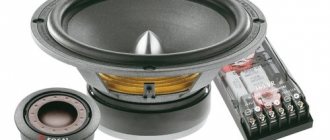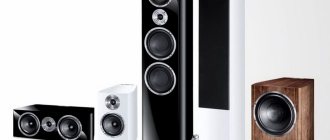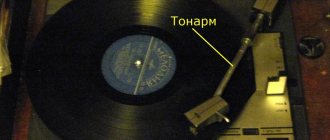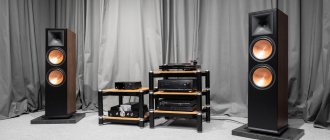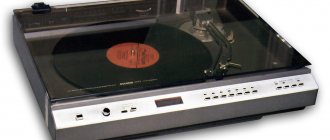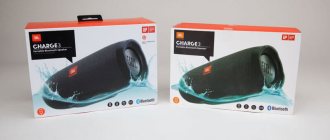Music lover's recipe
On the back wall of the closed cabinets there are only ladder terminal blocks with two pairs of fairly simple acoustic terminals for bi-wiring. The grills are made of very tough woven fabric and are installed flush into the raised frame of the front panel. Despite their lack of design flair, the speakers have a distinct, quiet, timeless style that makes them grow more appealing the longer you look at them. We had at our disposal a tube single-ended ultra-linear amplifier Unison Research Sinfonia, operating in pure class A and delivering 27 W per channel. With this solid tube setup, Klipsch speakers showed what they are truly capable of. The first pleasant emotions when listening to this combination were due to the free and natural presentation of natural instruments and the excellent development of timbral and microdynamic nuances. Solo vocals and duets allow you to admire all the variations of voice timbres and singing techniques. I was also captivated by the speaker’s ability to switch from a refined, clear baroque, with a web of rhythmic beats, a play of instrument shades and a clear arrangement of all the musicians on stage, to the powerful wave of tutti of the BSO, supported by the choir. Difficult moments such as intense dramatic soprano, brass or middle registers of the organ are also rich and full-bodied, although without excessive physicality or earthiness - the “thermal” balance is maintained very well. True, the speakers are not designed for loudness records, and in complex symphonic fragments the sound on the forte is still distorted and noticeably decreases in both speakers. But at reasonable power levels, the dense orchestral air immediately evokes a feeling of realism, and excellent proportions and separation of instrumental lines do not interfere with the full immersion in empathizing with the music. Heresy III is not at all characterized by analytical or dry presentation, they are musical and emotional to a very high degree. The bass, although limited at the bottom, has an excellent texture, rare in general and even rarer in this price range. Due to this, the lack of the lowest frequencies is completely compensated. In Gilels's "Appassionata" the lower register is magnificent, with a slight rumble and open piano strings, full and precise touches of the keys in the large octave. Acoustics does not physically reproduce these frequencies, but the ear, perceiving perfectly constructed overtones, completes the information without any problems. When switching from classical to hard genres, the speakers again surprise, making a contrasting transition from tremulous presentation to an assertive concert presentation, iron rhythm and weighty drums. The latter are generally among the favorites of the system with Heresy III; it clearly admires them and slightly emphasizes the crumbly drum rolls, allowing you to understand the character and playing style of different drummers. The detailed and separate practice of hitting the sticks on the cymbals makes us praise the resolution already at the upper frequencies. Again, in this price sector, I probably have not heard such delicately written rhythmic structures and after-sounds and such a good treble texture. The guitars are thick, dense and very tasty, plus the active and emotional voices of the vocalists, plus the rhythm, which seems to be simply basic and naturally inherent in the speakers - all this gives a completely unrealistic thrill from listening to rock and metal records. And once again it is worth noting the exceptional teamwork of the set of Klipsch Heresy III and Unison Research Sinfonia - they seem to be made for each other, there is not even a hint of lethargy, confusion in the middle or insufficient acoustic control. In popular music, speakers again exhibit a perfect sense of proportion. The vocalist in the foreground appears large, but not “the size of a carriage”; the arrangement of the musicians on the stage is felt almost visually. And, importantly, the Klipsch Heresy III is equally sympathetic to both new and old archival recordings.
Measurement results
Granddaughter. Klipsch Heresy III acoustics test
Klipsch Heresy speakers were born in 1957. And the current, already third, version of these well-deserved speakers has been produced since 2006. So, meet Klipsch Heresy lll. A modern interpretation of an American classic from sixty years ago.
In today's acoustics market, Klipsch is a unique phenomenon. The company's product range includes the Heritage line, which today includes four speaker models: Klipschorn, La Scala, Cornwall and Heresy, each of which has a progenitor from the middle of the last century. The number after the name indicates the generation of this particular development. Accordingly, Klipsch Heresy lll is already the third edition. So what do we have? In appearance, the speakers absolutely correspond to that time, that is, the fifties of the last century. A strict medium-sized box is covered with natural veneer. Its size corresponds to today's idea of a very large shelf holder. This roughly corresponds to our 35 speakers originally from the USSR. The speakers come complete with a small stand for floor use.
Imagine, this is exactly what home speakers looked like fifty years ago. No glamor: everything is simple and functional. Today these boxes only resemble messengers from the field of hard pro-audio. Ascetic, one word.
The stand allows the body to tilt backwards. As listening showed, this floor position of the acoustics quite freely interprets the position of the stage: it all ends up at your feet. Which is quite unusual, as if the listener were sitting somewhere in the gallery. Well, okay, in the gallery, so in the gallery. Moreover, these boxes are the most affordable of the entire vintage line of the company. Probably, such a hierarchy is quite appropriate: how much you paid for the entrance ticket to the world of vintage, that’s where you’ll be put. But seriously, to correctly form the drawn space, you will have to position the speakers using additional means, for example, stands 400–600 millimeters tall, if you have a seated listener in mind. Continuing the theme of design, I would like to draw attention to the combination of a closed box and a 12-inch emitter with a diffuser made of fiber composite, unusual for our days. In appearance, this “composite” is no different from ordinary paper. Most likely, this buzzword was coined by marketers, but on the other hand, all decent cellulose diffusers very often had fiber additives. Previously, wool was added to paper, but in recent years carbon fibers have often been added. Go ahead. The design is three-way, where the mid- and high-frequency emitters are compression devices. The 1.75-inch midrange driver drives an exponential horn, and the one-inch high-frequency driver drives a tractress. Their diaphragms are made of titanium. It is clear that all the emitters used are purely modern and high-tech products. I couldn’t find out anything about magnets, I think I won’t be mistaken if I assume the presence of rare earth in the drivers and ferrite in the woofer. All the more interesting is the final result that the company’s modern designers managed to develop in such a truly retro design, which is the Klipsch Heresy. I personally heard version two about ten years ago. And I must say that music lived there. And from the first one I came across individual Electrovoice tweeters, the model, it seems, was called T 35. Then, in the 50s and 60s, Klipsch used high-quality drivers of this famous brand in its speakers.
Listening to the new Heresy revealed the characteristic rounded, convex and open presentation of horn drivers. True, with quite significant limitations on the operating range at the edges. There is usually no need to talk about the deepest bottom in such a low-frequency design, but unfortunately, the highest frequencies are also missing here. This begs the question about the properties of the HF link itself, primarily its bandwidth and sensitivity. The scale of the images drawn by the column noticeably decreases with increasing frequency. The tonality at the bottom is close to ideal, in the driver's area of responsibility it shifts to light. I liked the dynamic breadth and genre omnivorous nature of the acoustics. I was somewhat confused, however, by the periodic brutality and even rudeness in the vocal range. Most likely, this can come from the super-powerful rare earth magnetic systems of the midrange and RF drivers and their titanium diaphragms. You hear something like a constant, appropriate or not, reminder of your power and dynamic capabilities. It is also possible that this will mostly go away as it warms up. And yet: undoubtedly, this is Klipsch. Without a doubt, it's Heresy. It is also clear that this is a new generation Heresy. I think it makes sense to talk about his place in the history of the company in twenty years. What is twenty years for vintage? Yes, practically nothing!
The frequency response of the model on the axis is quite flat. When deviating from it, a rather narrow focus in the range of action of the midrange HF horns comes to the fore. Thus, these speakers need fairly precise placement in the room. At the junction of the midrange and HF section, a rather sharp drop in return is noticeable, most likely due to the acoustic interaction of two closely spaced horns. This modulation anomaly may well be responsible for the audible roughness in the midrange. The SOI graph shows a fairly low percentage of distortion. The impedance curve behaves somewhat unusually. Especially in the mid/high frequency region. Firstly, this suggests a mismatch between the initial impedances of the compression drivers for this design. And secondly, about the crossover itself. Below we see one (closed box) and rather high impedance hump, in the region of 70 Hz, which manifests itself as enlargement and buzzing at this frequency.
Horn legend. Klipsch Audio Heresy III.
The history of all horn speakers begins in the USA. In the mid-1940s, the then unknown company Klipsch Audio began its difficult path to conquering the global market of the Hi-End industry.
The company began with a small workshop in the small American town of Hope, where mainly military families lived, and became a large and influential player in the global market of the Hi-End industry.
The founder of the company, engineer, musician, and a person who simply loves life, Paul Wilbur Klipsch is revered not only in America, but also far beyond its borders. All music lovers in the world pronounce his name with great respect, because this man created the legendary acoustic systems, which for many years have not ceased to fascinate us with their unusual sound, and are an excellent investment for all fans of good sound.
The Klipsch Audio Heresy III speaker systems that we will be reviewing today are the entry-level speakers in the classic Heritage line. Externally, Heresy III resembles a nondescript box with speakers, which is mounted on a small floor stand, due to which the speaker system has a slight tilt back.
As you can see, the model name contains the index III, which indicates that this is the third modification of Heresy. The first Heresy model was manufactured in 1957. Originally it was supposed to work as a complement to the older Klipschorn series speakers installed in the corners of the room, as a center speaker, to improve their volume and stereo presentation, which, of course, was complete nonsense, heresy. In English, “heresy” is Heresy. This is how, first as a joke, and then seriously, the model got its name. In 1985, the second modified version of Heresy II appeared, and another 21 years later, in honor of the company’s 60th anniversary, the third, today’s modification of Heresy III appeared, which we have had the opportunity to enjoy for the past 8 years.
The main difference between the second and third Heresy is the use of midrange/high-frequency speakers made of more modern material, and the ability to connect via bi-wiring. The body of the speaker system has an acoustically closed design (there is no bass reflex) and is made of 18 mm MDF sheets . Heresy III is covered with expensive natural walnut veneer on top.
The Klipsch Heresy III 12-inch bass speaker is made using classic technology from paper pulp with the addition of directional fibers and is equipped with a corrugated suspension. According to the manufacturer, such a speaker can withstand quite large overloads. The tweeters and midrange speakers have a horn design, the first is loaded on an exponential horn, the second - on the patented Tractrix, which is invariably present in all the company's models. Thanks to this, Heresy III have an easily recognizable sound character.
As personal practice shows, Heresy III begins to show all the beauty and depth of its sound when connected to a single-ended tube amplifier. The Italian Unison Research works superbly in tandem with them. Our next test is the Unison Research Preludio and the Klipsch Heresy III.



